Upper Dells – 1
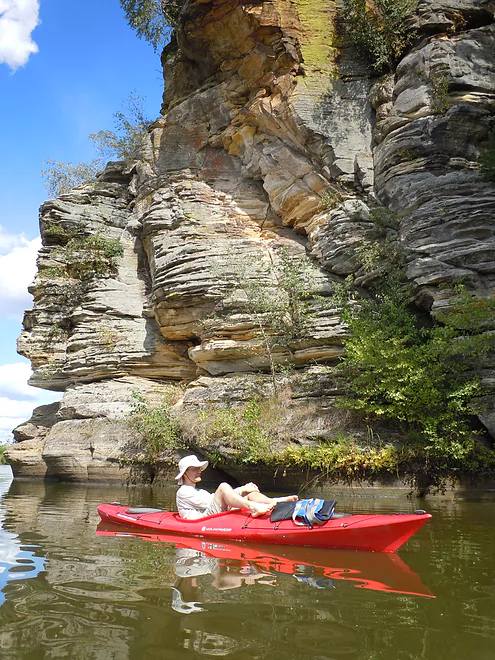





The most famous section of the Wisconsin River is in the Wisconsin Dells area. This is commonly divided into ‘Lower Dells’ (below the Kilbourn Dam) and ‘Upper Dells’ (above the Kilbourn Dam). And in the Upper Dells you can kind of divide that in half….this review will be about that upstream half.
The put in will be at the Two Rivers landing, located at the mouth of the Lemonweir River. This is considered by many to be the ‘start of the Dells’ (and was where an early proposed national park map would have started). The landing itself is very secluded, but nice–with parking and bathrooms. Once you put in there will be a nice rock formation straight ahead which marks the entrance of the Wisconsin River. On the east bank there is another nice rock formation that requires a little upstream paddling. Here in this inlet, the water is very clear and there is a cool indented cave inside on the bluffs where somebody tied a simple rope ladder to some tree roots and piled stones to climb up to the cave. During flood stage, you can explore this inlet upstream for a couple of more bluffs and you should even be able to paddle under Hwy 13.
In this 7 mile stretch, you can kind of divide it into three parts: A ‘bluffs’ section along the river. A wooded island and channel section without bluffs. Then the lake section…with very cool bluffs. After you put in at Two Rivers, you will see nice bluffs on both side of the river for the next few miles. As you enter the ‘island section’ (probably created by the artificial lake slowing down the sediment), you’ll be paddling past wooded banks with (honestly) probably nothing too special except wildlife (we saw turtles, eagles and huge carp). During higher water, you should be able to explore the smaller channels. Here and there are occasional sandbars which you can stop at and have lunch if need be.
If you stay to your right, you’ll see a massive bluff that is very photogenic (I believe it is called Louis Bluff). This kind of marks the start of the artificial lake created by the dam. Looking over the lake, you’ll see the massive Holiday Shores RV Park/Landing on your left (this is a private landing and requires a long drive through a restricted speed zone). Downstream on your left, you will see massive bluffs with an inlet known as Witches Gulch. On your right (west bank) you’ll see another series of bluffs after Louis, an inlet (that goes to the Town of Lyndon landing by River Bay Resort…hard to see), and then there is Stand Rock. You’ll mostly just see the Tour Boat docks and some of the surrounding rock formations instead of Stand Rock itself. Most reviews of the Upper Dells warn against going during busy times because the wake can be kind of rough for kayaks (and the rock walls don’t dissipate the waves like normal shoreline would). While this may be true for sections downstream, like in the narrows, I didn’t find the wake to be a problem for this upper section of the Upper Dells. In fact, boat traffic was quite light and I suspect this is because the water is too shallow for them to get upstream of the lake and it is also getting pretty far away from Wisconsin Dells. Once you get out onto the Lake for the last few miles, there are some wake issues, but they didn’t seem too bad. Be vigilant for the giant jet boats, as the wake they create is always hazardous no matter the section of river you are on. To kind of sum up the difference between the top 7 miles of the Upper Dells and the lower 7 miles of the Upper Dells, you can say the upstream section is much less touristy with much less traffic, and while it has very nice rock formations, the downstream section probably has better rock formations and gullies. In the future I hope to review the rest of the Upper Dells, including the narrows and the surrounding gulches.
Assuming you are following the route I suggest, you’ll hug the right shore, then paddle a little upstream into a hidden inlet where the Town of Lyndon landing by River Bay is (you’ll see a massive steamboat called the Princess Kay there). You also might be able to hear the neighboring stock car races from this area (we could hear the cars all the way from the lake). This landing, while is public, charges 5 dollars per car. The surrounding River Bay harbor and residential park unfortunately creates a busy and noisy atmosphere, but the landing is decent with bathrooms. Parking can be a problem though if you go later in the day during a weekend. There are problemat dogs and their entrails throughout the landing, which is unfortunate. You can take out at other landings… There is a small quiet county landing (see map for all these references) on the northeast side of the lake. I think this is free…but requires going over one the bridges to get there. A little downstream, also on the east bank, there is Holiday Shores, which is another private landing even busier than River Bay more intended for power boaters and I believe they charge more than the 5 dollars the Town of Lyndon landing charges. If you bypass the lake…you really make this a longer trip. I don’t know if there are landings on the narrows…but there is a nice landing on the west side of Black Hawk Island. Assuming no side-adventures (like gulches) this is only ~4 miles from River Bay, for a total of 11 miles from Two Rivers (although you do want to explore the gulches). Then there is a city ramp in Wisconsin Dells (east bank) but I believe they charge quite a bit.
After your trip, you may consider exploring some of the famous landmarks in the area. Most people don’t know this, but many of the famous sites like Stand Rock, Witches Gulch, Roods Glen and Cold Water Canyon do not require purchasing a 25 dollar ticket from the Dells Boat company to explore. Most (at least Stand Rock and Witches Gulch) can be accessed by side roads for a fee of three dollars per person. A frugal alternative to purchasing boat tickets to explore these areas! The gates for these attractions do close at 6, I believe though. Definitely call the boat company for hours and times of these special access areas, as the times do change. Many don’t know it, but much of the Dells is owned by the state of Wisconsin. In the case of Stand Rock/Witches Gulch/Coldwater Canyon, the Dells Boat company has a deal in which they have signed a lease that guarantees exclusive access and use rights to these public areas. The state also owns Black Hawk Island (which they let a 4H company manage). You can access that area by paying for a boat/hike tour with them. For the Lower Dells, again the state owns much of that, but in this case they mostly let the local duck companies manage these areas.
Quick Overview
- Upstream of Stevens Point: I don't have information yet on these stretches.
- Stevens Point to Lake Petenwell: ~42 miles. This stretch in Central Wisconsin used to have many natural rapids, but most have been buried under 8 dams, some of which are now difficult portages. Despite this there is still some good paddling to be had in this region.
- Lake Petenwell: 14.9 miles. This is a large flowage lake that is challenging for paddlers because of frequent strong winds and big waves.
- Castle Rock Lake: 14.5 miles. Another large flowage lake that is likely too big for enjoyable paddling.
- Castle Rock Lake Dam to Lemonweir River: 9.4 miles. This pre-Dells leg isn't elite, but is a pleasant stretch.
- Lemonweir River to Indian Trails Landing: 21.7 miles. This includes the famous Upper Dells and Lower Dells which feature many scenic sandstone outcrops.
- Indian Trails Landing to Portage: 16 miles. This is an overlooked section sandwiched between the Dells and Portage. While the scenery isn't top-notch, it does have many sandbars and few people which is a nice combination.
- Portage to Lake Wisconsin: 14.3 miles. This is a neat stretch of the river with many sandbars and cliffs, but the shoreline is very developed and motorboat traffic can be heavy on weekends.
- Lake Wisconsin: 14.5 miles. This is a challenging lake for paddling because of the huge and frequent waves created by motorboats.
- Prairie du Sac Dam to Port Andrews: 57 miles. This is the first half of the famous Lower Wisconsin Riverway. This is a super popular stretch for paddlers with the highlights being large sandbars, big bluffs, occasional cliffs, and fun side sloughs to explore.
- Port Andrews to Wyalusing: 40 miles. This is the second half of the Lower Wisconsin Riverway which has far fewer paddlers and sandbars. But the bluffs and sloughs are larger and more interesting.
Detailed Overview
- Upstream of Merrill: I don't have enough information yet on these legs to comment.
- Merrill Dam to Riverside Park: 0.5 miles. Might include some light rapids below the dam.
- Riverside Park in Merrill to Wisconsin River Forest Landing: 8.6 miles. A good prospect.
- Wisconsin River Forest Landing to Brokaw Boat Landing: 5.7 miles.
- Wisconsin River Forest Landing to Jesse Park: 1.4 miles. A terrific stretch with small boulder gardens, one set of Class 1-2 rapids, gravel bars and a nice sand bank.
- Jesse Park to Brokaw Boat Landing: 4.3 miles. A good stretch with scenic wooded banks and occasional gravel bars.
- Brokaw Boat Landing to Gilbert Park: 5.1 miles. River slows down and becomes hillier. This stretch is an ok prospect and goes past the old Brokaw paper plant that has been shut down. Paddlers must navigate Class 1 rapids and 2' drop where the old Brokaw dam used to be.
- Gilbert Park to Wausau Boat Dock: 1.5 miles. An impounded stretch through Wausau. There are numerous alternate access options to choose from.
- Wausau Boat Dock to Oak Island Boat Ramp: 1.2 miles. A nice stretch that includes Barkers Island and Isle of Ferns Park. But the Wausau dam does require a portage. This stretch parallels the famous Wausau Whitewater Park.
- Oak Island Boat Ramp to Rothschild Dam Access: 5.8 miles. Likely mostly uninteresting flowage paddling. There are many alternate access options to choose from.
- Rothschild Dam Access to Zimpro Park: 1.0 miles. This might be a nice stretch.
- Zimpro Park to River Road Boat Landing: 7.6 miles. The first half of this leg is likely nice river paddling, but the second leg is probably just an uninteresting flowage.
- Chucks Landing/Mosinee Dam to Bean's Eddy Boat Landing: 2.8 miles. Likely a nice leg. You might be able to launch by the dam where there should be some nice rapids and boulders.
- Bean's Eddy Boat Landing to Seagull Boat Landing: 5.1 miles. Mostly uninteresting flowage paddling. Although there might be some nice sand banks on the eastern shore.
- Seagull Boat Landing to Dubay Dam Access: 5.3 miles. Mostly uninteresting flowage paddling.
- Dubay Dam Access to River Road Landing: 5.5 miles. This could be a nice stretch of river.
- River Road Landing to Old US 10 Landing: 2.3 miles. Likely an ok leg.
- Old US 10 Landing to Stevens Point Dam: 5.6 miles. Probably uninteresting flowage paddling. Many alternate access options closer to Stevens Point.
- Stevens Point Dam to Blue Heron Boat Landing: 4.2 miles.
- Steven Point Dam to Whiting Dam: 2.6 miles. Starts slow and uninteresting, but the river becomes very scenic after the Hwy HH bridge. The rock formations below both dams are very striking. Many alt access points.
- Whiting Dam to Kimberly Clark Dam/Al Tech Park: 0.6 miles. Incredible scenery with exposed bedrock and boulder gardens below the Whiting Dam. Some rapids, but nothing major. The Kimberly Clark Dam is a dangerous low-head dam and should be treated carefully.
- Kimberly Clark Dam to Blue Heron Landing: 1.0 miles. Class 2 rapids below the dam, but after that the river slows dramatically and splits into many sub-channels and islands. Round trips on this leg are possible. I chose the far western channel where there were some nice rocky stretches.
- Blue Heron Landing to Mill Creek Landing: 4.1 miles. Likely a mediocre paddle with nothing special. Galecke Park is an alternate access.
- Mill Creek Landing to Biron Dam North Gate: 7.6 miles. Mostly uninteresting flowage paddling. Several alternate access options on route.
- Biron Dam North Gate to Veteran's Memorial Park: 4.5 miles.
- Biron Dam North Gate to Biron Landing: 1.0 miles. Super scenic stretch by two islands with many granite boulders.
- Biron Landing to Legion Park: 3.0 miles. A nice stretch by Big Island. The west channel is more undeveloped...but the east channel has several scenic granite islands.
- Portage through Legion Park: 680'. A steep wall separates the park from the river but in two locations the wall is short enough to get over (see map). Paddlers may want to consider a longer portage to bypass some of the shallow rocky stretches by Legion Park.
- Legion Park to Veteran's Memorial Park: 0.4 miles. A scenic stretch that features a large boulder field and the powerhouse of a large paper mill.
- Veteran's Memorial Park to Port Edwards Landing: 3.8 miles
- Veteran's Memorial Park to Demitz Park: 0.8 miles. A pleasant stretch that includes Belle Island.
- Demitz Park to Ben Hansen Park: 1.2 miles. This leg goes by Garrison Island and Edwards Island. Lyon Park is located across the river from Demitz Park and is another access option.
- Ben Hansen Park to Port Edwards Landing: 1.8 miles. Nice prospect that includes paddling past some historic islands. The Centralia dam should be an easy portage (east bank by golf course).
- Port Edwards Landing to Nekoosa/Riverside Park: 3.6 miles.
- Port Edwards Landing to Port Edwards Powerhouse: 1.3 miles. A half-mile portage is required. A very scenic boulder field is located below the dam. At high levels, the rocks are submerged and produce a half mile stretch of rapids (some strong).
- Powerhouse to Moccasin Creek Landing: 1.8 miles. A generic wooded stretch that isn't super interesting.
- Moccasin Creek Landing to Riverside Park: 0.5 miles. During the Nekoosa dam drawdown, this stretch had nice boulder fields and rapids.
- Riverside Park to Hwy 73: 0.8 miles. An ok stretch of the river. There are scenic cliffs south of Hwy 73, but these are past the dam warning line. Hwy 73 is not a good access option.
- Hwy 73 to Point Basse Ave (Portage of the Nekoosa Dam): 1.5 miles. A difficult 1.5 mile portage through downtown Nekoosa. Don't try to portage the south bank. There is a steep hill, cliffs, and large Domtar paper mill fences to deal with.
- Point Basse Ave to Jim Freeman Memorial Boat Landing: 0.8 miles. A generic stretch going by historic Point Basse. If you're willing to backtrack to the dam, you can see scenic boulder fields (during low flows) and a few cliffs. Point Basse Ave is a somewhat speculative access, but it seems public and doable for launching.
- Jim Freeman Memorial Boat Landing to Plank Hill Small Boat Access: 2.0 miles. Generic stretch.
- Plank Hill Small Boat Access to 19th Drive Landing: 5.3 miles. Features two epic sand banks. The main channel has some minor sandbars. Several of the side sloughs can provide fun side adventures.
- 19th Drive to the Petenwell Dam: 14.9 miles. This is Lake Petenwell which is a large and challenging lake for paddling. Waves and strong winds are frequently an issue. But when calm there are nice sandbanks on the northwest shore, hidden sloughs, and large islands to explore. See the overview map for more info.
- Petenwell Dam to Ganter Lane Landing: 3.8 miles. This stretch isn't too impacted by dams and may have nice sandbars at low levels.
- Ganter Lane Landing to Castle Rock Lake Dam: 10.7 miles. Castle Rock Lake is likely too big (wind/waves) for enjoyable paddling. There are many alternate launch options along the shore.
- Castle Rock Lake to the Lemonweir River: 10 miles. An ok section.
- Lemonweir River Mouth to River Bay Landing: 7 miles. The first half of the classic Upper Dells.
- River Bay Landing to Blackhawk Island: 6.5 miles. Second half of the classic Upper Dells known for its fantastic outcrops. Note, the Blackhawk Island landing is no longer accessible without special permission from the local 4H club.
- Black Hawk Island to Wisconsin Dells Dam: 2.0 miles. More nice sandstone outcrops. You can take out at a public ramp off Indiana Ave or portage the dam and take out SW of the dam by a launch off Wisconsin Dells Pkwy/Hwy 12.
- Dells Dam to Indian Trails Landing: 6.2 miles.
- Dells Dam to Newport Park: 2.2 miles. This is the heart of the famous Lower Dells with many scenic outcrops. Unfortunately jet boats are a serious plague on this stretch.
- Newport Park to Indian Trails Landing: 4.0 miles. Features the famous "Sugar Bowl" and four super cool caves. The outcrops soon disappear and this stretch is mostly uneventful (but peaceful) big river paddling.
- Indian Trails Landing to Pine Island Boat Ramp: 9.8 miles. Few paddle this stretch as it isn't as interesting. But...it does have a good concentration of sandbars and few competing paddlers for them.
- Pine Island Boat Ramp to Portage/Hwy 33 Access: 6.0 miles. Not an elite section that is lacking in cliffs and bluffs. It does have good sandbars though.
- Portage to Dekorra Park: 7.7 miles
- Portage to Baraboo River/Thunderbird Road: 5.2 miles. A good section with great sandbars. Close to Portage there are few motorboats.
- Baraboo River to Dekorra Park: 2.5 miles. River splits around massive Lib Cross Island. West channel has nice sandbars. St Lawrence Bluff has scenic sandstone outcrops and includes a cave you can paddle into.
- Dekorra Park to James Whalen Memorial Park: 6.6 miles.
- Dekorra Park to Camp Rest Park: 5.1 miles. A terrific section with rock outcrops, large island deltas, hidden sloughs, and nice sandbars. Unfortunately this part of the river is popular with motorboats and jet skis which can be a plague. Multiple alternate access options.
- Camp Rest Park to James Whalen Memorial Park: 1.5 miles. Not a great section because of the open water paddling, powerboats and big waves. The west shore though does have nice outcrops.
- James Whalen Memorial Park to Merrimac Memorial Park: 4.4 miles. River turns into "Lake Wisconsin". Generally speaking this isn't ideal for kayaking as motorboat traffic can be heavy and waves can be surprisingly big. Most direct route is the north shore which has a few bluffs, but generally speaking isn't that interesting.
- Merrimac Memorial Park to Veterans Memorial Park/Prairie du Sac: 9.6 miles.
- Merrimac Memorial Park to Moon Valley Landing: 3.3 miles. Includes a lot of developed shoreline. The ferry, railroad bridge, and Moon Bay are highlights.
- Moon Valley Landing to Veterans Memorial Park/Prairie du Sac: 6.3 miles. Other than Moon Bay and the dam, this is a boring stretch. There are numerous alt access options on this route.
- Prairie du Sac to Mazomanie: 8 miles. An ok section of the Wisconsin but lacking in sandbars.
- Mazomanie to Arena: 9.7 miles. A great section with nice sandbars and scenic bluffs.
- Arena to Hwy 14: 8.0 miles. Good section with a high concentration of sandbars. One of the more popular legs on the Lower Wisconsin.
- Hwy 14 to Hwy 23/Spring Green: 2.2 miles. Neat mini-section with sandstone outcrops. Very popular in the summer.
- Spring Green to Lone Rock: 7.4 miles. Another fine sandbar/bluff section with some nice rock outcrops too.
- Lone Rock to Gotham: 8 miles. This stretch has super impressive rock outcrops and sand banks.
- Gotham to Muscoda: 7.6 miles. This leg includes more large sandbars and great outcrops. Bonus highlights include fast current and not seeing as many people.
- Muscoda to Port Andrew: 7 miles. A good stretch with many islands and sandbars.
- Port Andrew to Boscobel: 9 miles. Wooded islands start to get massive.
- Boscobel to Woodman/Big Green River: 9 miles and start of the less paddled stretch of the Lower Wisconsin. Far fewer sandbars from here to the mouth, but good bluffs and side sloughs to explore.
- Woodman to Adiantum Woods State Natural Area: 3.9 miles. Good stretch with large islands.
- Adiantum Woods State Natural Area to Millville: 3.8 miles. Good stretch with large bluffs and sandbars.
- Millville to Bridgeport: 5.3 miles. A peaceful stretch with few paddlers, yet good river bluffs and islands.
- Bridgeport to Wyalusing (the mouth): 9 miles.
Trip Map
View Upper Dells -1 in a larger map






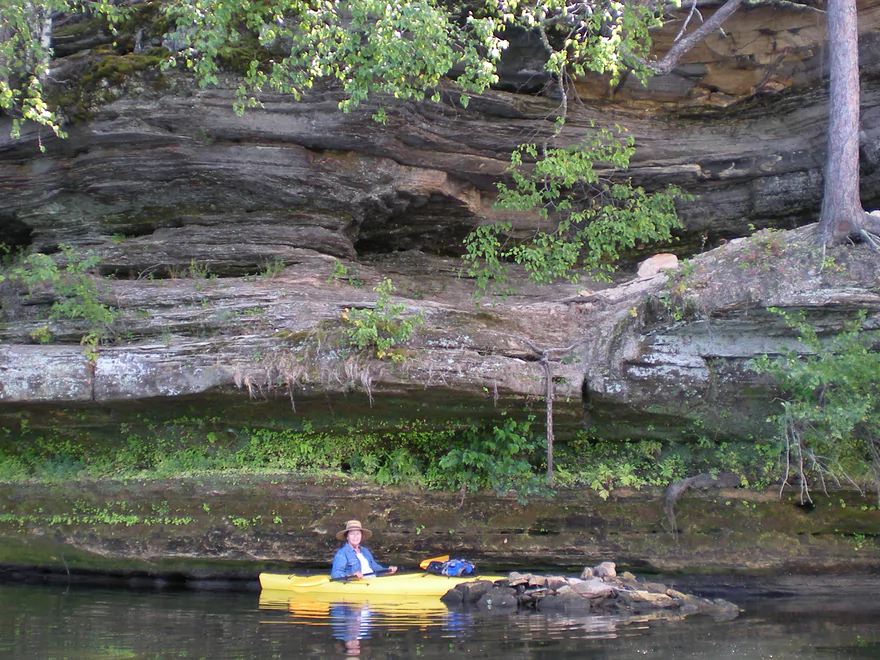
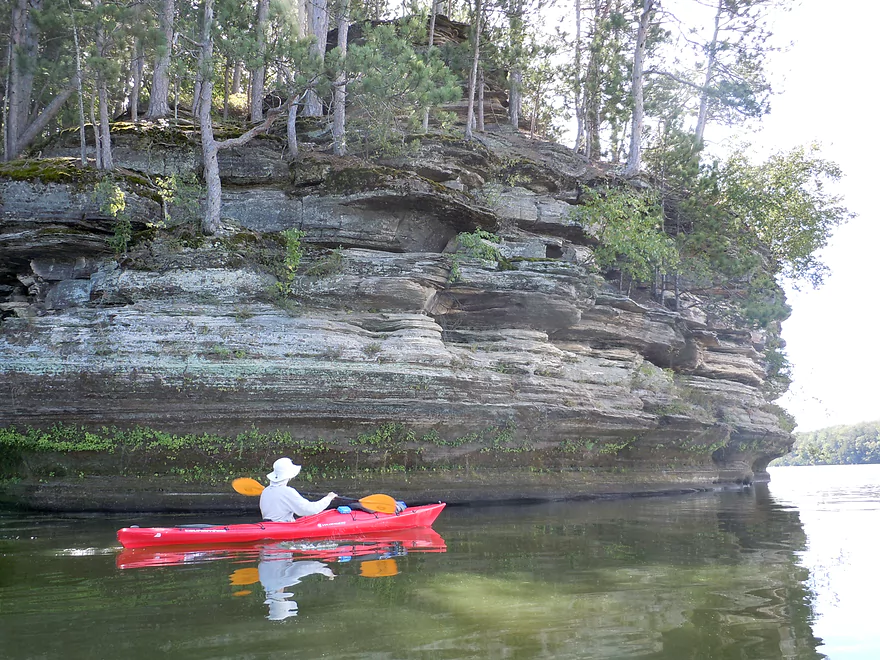













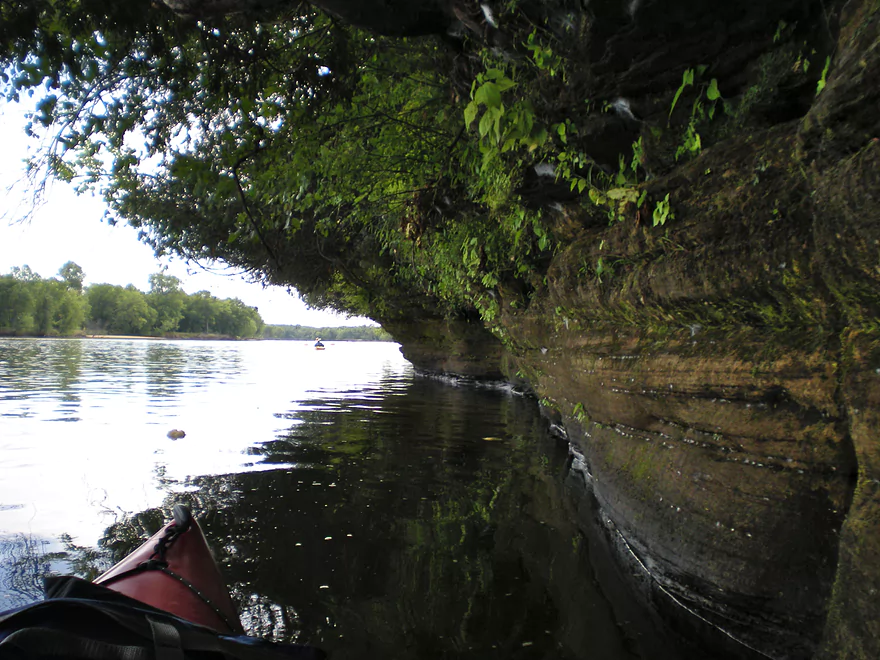

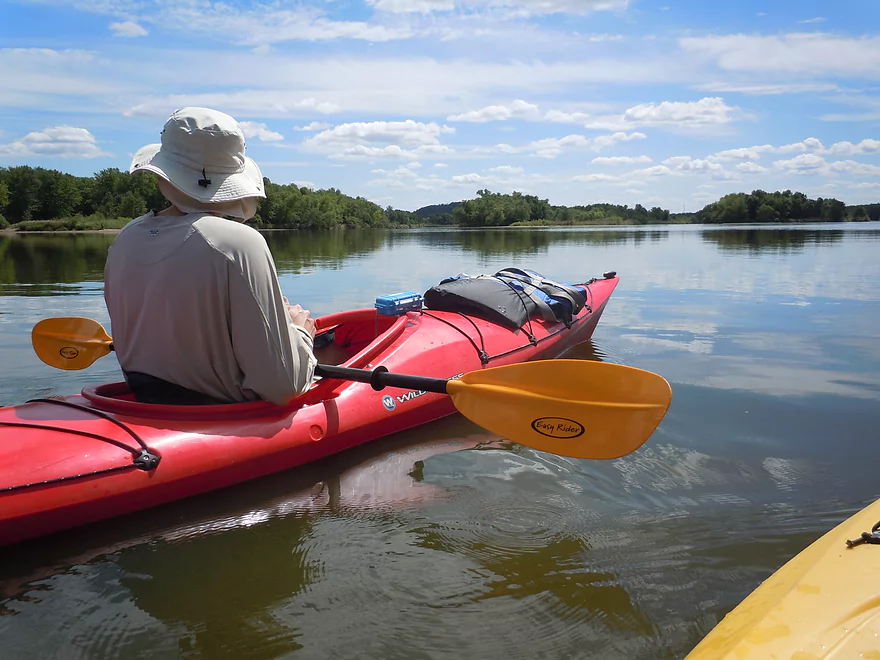











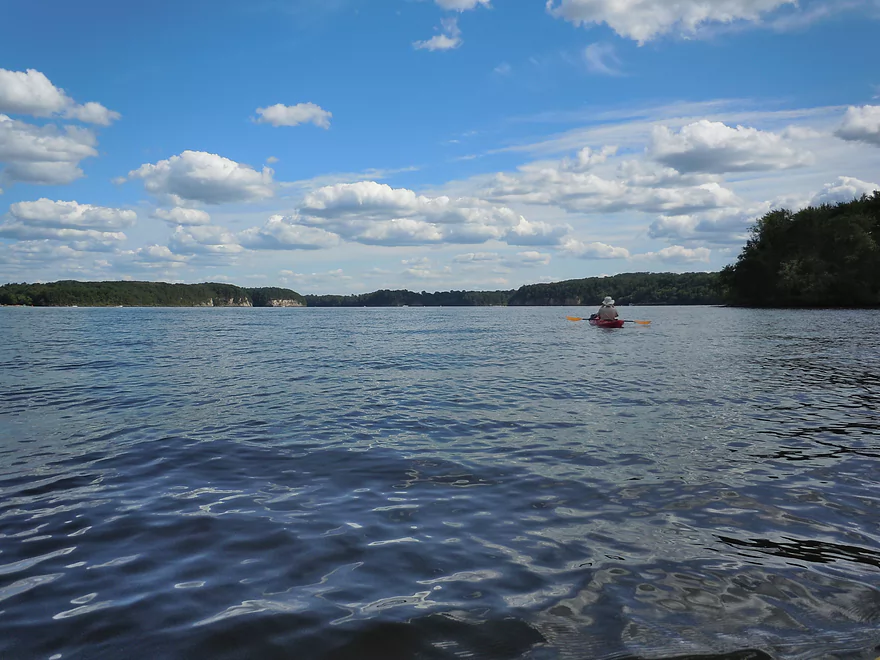







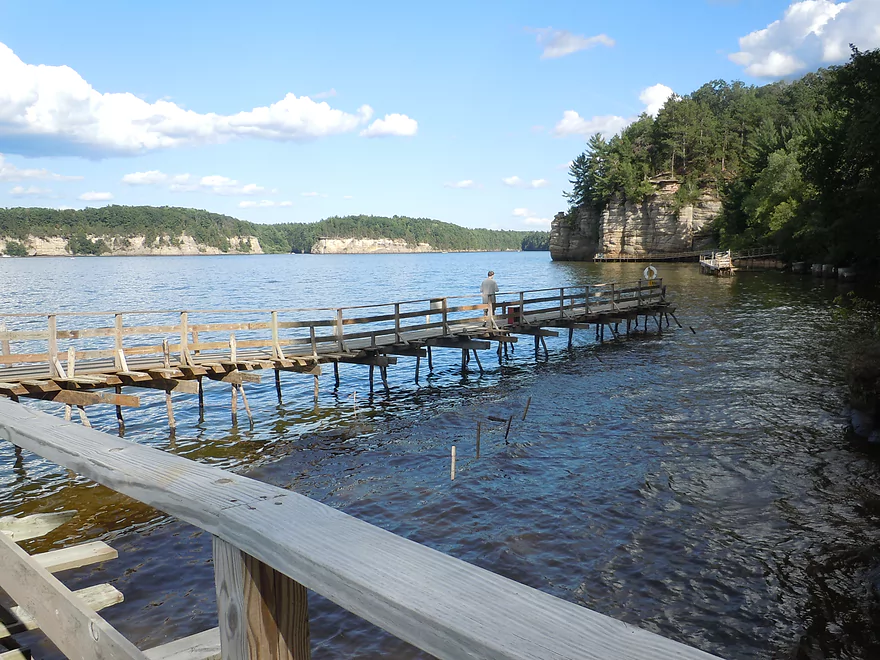


Hi, We are headed to the dells this july. I notice you say that we can access Standing Rock &another cool site via a road for a small fee. I cannot find any information on how to do that. Can you direct me to a site that would help?
Loved your photos and greatly appreciate your detailed info.
Best, sharon Shepherd
Hi Sharon,
Yes, you can access Stand Rock (west shore) and Witches Gulch (east shore) from direct inland access points. Access to these areas is administrated by “Dells Boat Tours” and you can call them at 608-254-7227 for more information. There are small access roads leading to each. I’ll email you specific map locations here in a bit.